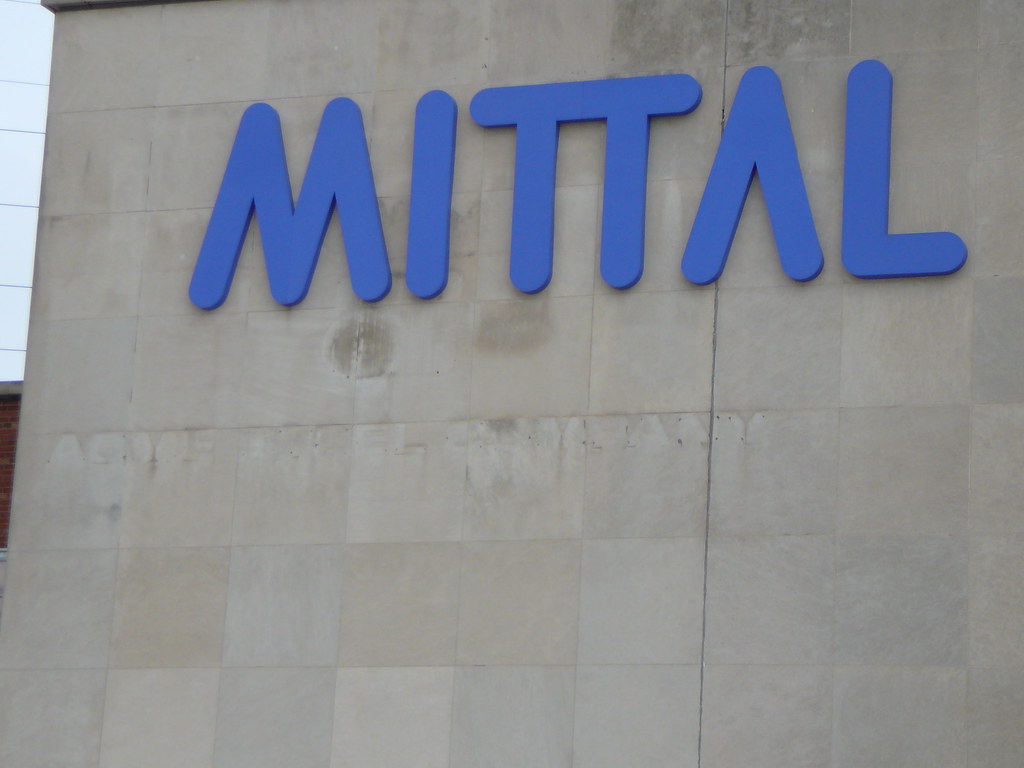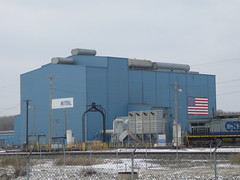After my time with the apprentices, I drove east to take some pictures of the Mittal Steel facility in Riverdale, Illinois. Back in December I saw this from the City of New Orleans as I rode into Chicago, but couldn't get a good shot. At first, the giant U.S. flag painted on the side of the building caught my eye, and only after a moment did I notice the MITTAL logo on the other wall of the plant. It's hard to get a better pairing of "heartland" and "global" imagery.
Arcelor-Mittal is the largest steel manufacturer in the world, the result of a hostile take over of the Luxembourg-based Arcelor by UK-based, and family-owned, Mittal. The driving force behind Mittal steel is the Indian-born Lakshmi Mittal, the third richest man in the world behind Bill Gates and Warren Buffet. The company grew very quickly during the 1990s and early 2000s through buy-outs of former government-owned facilities thoughout the world, and bankrupt firms like Bethlehem in the US. Lots of background information and analysis is available at the Making Steel site.
 The Riverdale mill was once part of Acme Steel, and you can still see the faint outline of the old company name on the facade of the office building near the plant.
The Riverdale mill was once part of Acme Steel, and you can still see the faint outline of the old company name on the facade of the office building near the plant.Apparently, the Riverdale facility was part of the ISG steel group (along with most of the former Bethlehem steel), and went to Mittal with the ISG buyout. ISG and the United Steelworkers had revived some of these mills from the edge of extinction with an innovative agreement to scrap most of the union's traditional work rules (among other things). This is the subject of an interesting, if limited, documentary called "Rustbelt Phoenix." Workers at the Riverdale mill are still represented by the USW, but the industry that once employed more than half a million workers--almost all union--is now a shell of its former self.
I also recently went to visit the Nucor Scrap Mill in Kankakee. Although it is U.S.-owned, Nucor is also part of the story of the demise of Big Steel in the U.S.
There are a couple of pictures of Nucor, and more pictures of Mittal, in the Global Heartland photo pool on Flickr.


2 comments:
I think the U.S. flag phenomenon at industrial sites is an interesting one. What's to stop Loyola University from painting a gigantic flag on one of their buildings? Why don't Chicago's loop office buildings do the same thing? In sum, why is this peculiar to large industrial sites? Why isn't a flag enough? Is everyone else less patriotic? I did read in the newspaper a while back that Donald Trump is in trouble with some of his Florida neighbors because he's flying a super-sized American flag in one of his homes there. - TL
Hey Tim--I think it's fair to say that many folks who work in manufacturing and construction trades are very patriotic in a traditional flag-waving way. They can have their problems with the government too, but the flag plays well in Peoria, as the saying goes.
I recall the flag, and flag rhetoric, as prominent during the Staley lockout in Decatur during the 1990s. In that case, the company had been bought by a British multinational--so people even talked about the "Redcoats". I imagine in the case of the Riverdale mill, the flag predated the buyout by Mittal. So it may be a kind of statement of resistence that it remains on the wall.
Thanks for the comment!
Post a Comment